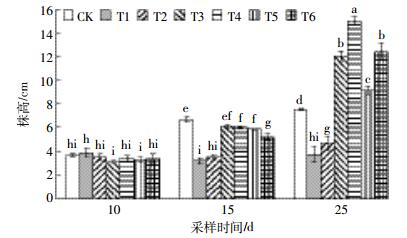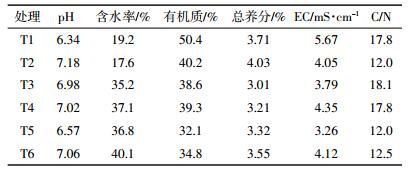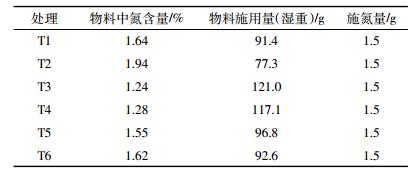文章信息
- 王亚利, 杨光, 熊才耘, 谢尚宏, 李银生, 曹林奎, 赵琦
- WANG Ya-li, YANG Guang, XIONG Cai-yun, XIE Shang-hong, LI Yin-sheng, CAO Lin-kui, ZHAO Qi
- 蔬菜废弃物蚯蚓堆肥对鸡毛菜生长的影响
- Effect of vegetable waste vermicompost on the growth of Brassica chinensis
- 农业环境科学学报, 2017, 36(10): 2129-2135
- Journal of Agro-Environment Science, 2017, 36(10): 2129-2135
- http://dx.doi.org/10.11654/jaes.2017-0335
文章历史
- 收稿日期: 2017-03-10
我国是蔬菜大国,蔬菜种植面积和产量均居世界第一,分别占世界蔬菜种植面积和产量的41.75%和50.96%[1]。据统计,2013年我国蔬菜种植面积为2.09×107 hm2,各类蔬菜年产量高达7.35×108 t,又因蔬菜在流通中的折损比例较高(约37%),同年,我国蔬菜废弃物的总产量高达约2.69×108 t[2],成为我国仅次于水稻、玉米和小麦秸秆的第四大农作物废弃物[3]。蔬菜废弃物的含水量可高达75%~95%[4],且具有保存周期短、不易运输和易腐烂等特点。尤其是夏天,腐烂的蔬菜废弃物更易为病害微生物的繁殖与传播提供条件,所含的矿质元素也会经地表径流冲刷和渗漏等途径进入地表水和地下水,造成农业面源污染。但同时,蔬菜废弃物中含有较高的营养成分,如氮(2.02%~5.69%)、磷(0.29%~3.25%)和钾(0.49%~5.37%)(以干物质计算),这与常用的天然有机肥料相当[5-7]。因此如何将蔬菜废弃物资源化再利用,实现蔬菜废弃物处理的减量化、能源化和资源化成为目前亟待解决的问题。
蚯蚓作为生态系统的工程师,被认为是农业治污除臭,变废为肥的重要土壤动物。它可利用自身丰富的酶系统(蛋白酶、脂肪酶、纤维酶、淀粉酶等)将有机废弃物迅速分解,并转化成易于利用的营养物质[8]。从90年代起,蚯蚓堆肥就已经被认为是一种低成本的生态环境友好的技术[9-12]。蚯蚓不仅每日能处理与其体重相当的有机废弃物,如污泥、动物粪便、蔬菜废弃物、秸秆和工业垃圾等[13-15],降低它们对周围环境的影响,而且可获得高效、稳定的有机肥,促进农作物生长,提高作物产量。蚯蚓堆肥富含大量腐植酸、有益微生物菌、多种氨基酸和微量元素,其团粒结构特殊,保水性强,是一种集营养、防病和刺激生长于一体的多功能有机肥料,同时也是贫瘠土壤和长期施用化肥导致板结的土壤的改良剂。因此,蚯蚓堆肥在农业生产中具有重大的发展潜力[16-17]。目前蚯蚓堆肥原料多为牛粪、污泥和秸秆等,鲜少使用蔬菜废弃物。蔬菜废弃物的高有机质含量和无毒害的特性使其成为蚯蚓较好的食物来源,而同常规高温堆肥相比,蚯蚓辅助堆肥工艺简单、能耗低,同时蚓粪和蚓体又可循环利用,可在处理废弃物的同时增加经济效益,是能够实现蔬菜废弃物循环利用的一项新处理技术[18]。
因此,本研究选取4种蔬菜废弃物有机肥和2种商品有机肥,研究其对鸡毛菜(Brassica chinensis,Linné)生长的影响,以期为蔬菜废弃物堆肥在农业生产上的应用提供数据支持和理论依据。
1 材料与方法 1.1 材料 1.1.1 有机肥本研究中使用的商业有机肥,一种是畜禽粪便(T1),来自奉贤农业技术推广服务中心,另一种是蚯蚓粪(T2),购于绿阳园艺。
T3~T6处理均为实验室制备的有机肥。制备有机肥的蔬菜废弃物来自松江叶榭镇蔬菜废弃物回收站,主要为叶菜类和果皮。蚯蚓(Eisenia fetida)购于上海桃源蚯蚓养殖场。有机肥制备方法如下:
T3:新鲜蔬菜废弃物+10%小麦秸秆普通堆肥(湿重比)
T4:新鲜蔬菜废弃物+10%小麦秸秆预发酵40 d后蚯蚓堆肥(湿重比)
T5:新鲜蔬菜废弃物普通堆肥
T6:新鲜蔬菜废弃物预发酵40 d后蚯蚓堆肥
堆肥前,将所有蔬菜废弃物放入具孔的塑料箱(长×宽×高=50 cm×40 cm×30 cm)中,周围铺设一圈细纱布以防止蚯蚓逃逸。在T4和T6处理中投放蚯蚓成体100条。第70 d停止堆肥,将所有堆肥产物作为有机肥。6种肥料的理化性质参数如表 1所示。
鸡毛菜(Brassica chinensis L.)的种子购于上海欣艺花园。
1.1.3 土壤土壤取自上海交通大学农场,理化性质如下:pH=7.75,EC=130 μS·cm-1,土壤为粘土,20%粘粒,有机质32.1 g·kg-1,总磷0.958 g·kg-1,总氮1.85 g·kg-1,总钾2.53 g·kg-1。
1.2 实验设计本实验在上海交通大学温室大棚中进行。温室大棚控制温度为(25±5)℃,湿度控制在60%~70%,鸡毛菜种植于底部具孔的泡沫箱(长×宽×高=23 cm×33 cm×23 cm)中,放入10.0 kg土壤,土壤取自上海交通大学农场,过2 mm筛。首先,将种子均匀洒播在表层,株距为5 cm。使用6种不同的有机肥种植鸡毛菜,每个处理3个重复,施氮量以上海菜地平均施氮水平37.5 kg·hm-2为标准(表 2)。以不施肥(CK)处理为对照,在鸡毛菜种植后的第1、5、10、15 d和25 d分别测定株高和叶面积。为减少误差,株高低于2 cm和叶面积小于2 cm2的样本忽略不计。在第25 d,收获鸡毛菜,杀青,烘干,研磨样品并过60目筛,备用。
全氮采用H2SO4-H2O2消煮法测定。全磷、全钾、全钙和全镁采用电感耦合等离子体发射光谱仪(iCAP6300-ICP,Thermo fisher)测定。
1.4 数据分析试验数据使用SPSS 22.0软件进行方差分析,多重比较采用LSD法检测5%显著性水平。
2 结果与分析 2.1 植物的生长情况 2.1.1 株高图 1显示了不同处理间鸡毛菜株高在第10、15 d和25 d的变化。第1 d和第5 d的高度低于检测水平,因此不在本研究讨论范围。所有处理的植物株高前10 d变化相似,差异不显著(P>0.05)。第15 d后,不同处理间的鸡毛菜株高变化较为明显。施用商品有机肥(T1和T2)的鸡毛菜株高显著低于其他处理(P < 0.05)。第25 d时,T4处理的鸡毛菜株高值达到最大,显著高于其他处理,且比株高值最小的T1处理高了3.00倍。T4与T6处理(蔬菜废弃物蚯蚓堆肥)的鸡毛菜株高显著高于T3和T5处理(蔬菜废弃物普通堆肥)。T3处理下的鸡毛菜株高高于T5处理。

|
| 第1 d和第5 d株高小于2 cm忽略不计。CK:不施肥对照;T1:畜禽粪便有机肥处理;T2:蚯蚓粪有机肥处理;T3:新鲜蔬菜废弃物+10%小麦秸秆普通堆肥处理;T4:新鲜蔬菜废弃物+10%小麦秸秆预发酵40 d后蚯蚓堆肥处理;T5:新鲜蔬菜废弃物普通堆肥处理;T6:新鲜蔬菜废弃物预发酵40 d后蚯蚓堆肥处理。不同小写字母表示处理间差异达显著水平(P < 0.05)。下同 The height less than 2 cm in the first and the fifth day was neglected. CK: Blank; T1: Treatment under commercial organic fertilizer 1 (livestock waste); T2: Treatment under commercial organic fertilizer 2 (earthworm cast); T3: Treatment under compost of fresh vegetable wastes plus 10% wheat straw; T4: Treatment under vermicompost of 40 days'prefermented fresh vegetable wastes plus 10% wheat straw; T5: Treatment under compost of fresh vegetable wastes; T6: Treatment under vermicompost of 40 days忆prefermented fresh vegetable wastes. Different letters above the columns differ at P < 0.05. The same below 图 1 不同处理下鸡毛菜株高的变化 Figure 1 Height of Brassica chinensis under seven treatments |
图 2显示了不同处理间鸡毛菜叶面积在第10、15 d和25 d的变化。第1 d和第5 d的叶面积,以及T1、T2和T6处理在第10 d的叶面积低于检测水平,因此不在本研究讨论范围。在15 d后,T4处理叶面积显著高于T5和T6处理(P < 0.05)。与株高相似,在第25 d,T4处理的鸡毛菜叶面积值达到最大,T1处理最小,两者之比达到3.53。加入10%秸秆的蔬菜废弃物堆肥处理(T3和T4)显著高于无秸秆的蔬菜废弃物堆肥处理(T5和T6)。T4和T6处理(蔬菜废弃物蚯蚓堆肥)的鸡毛菜叶面积分别高于T3和T5处理(蔬菜废弃物普通堆肥),且差异显著。

|
| 第1 d和第5 d的叶面积,以及T1、T2和T6处理在第10 d的叶面积小于2 cm2忽略不计 The leaf area less than 2 cm2 was neglected. 图 2 不同处理下鸡毛菜叶面积的变化 Figure 2 Leaf area of Brassica chinensis under seven treatments |
鸡毛菜和肥料中的氮、磷含量如表 3所示。氮、磷含量在商品肥料(T1和T2)中最高,尤其是磷的含量显著高于蔬菜废弃物堆肥。其次是无秸秆的蔬菜废弃物堆肥(T5和T6),加入10%秸秆的蔬菜废弃物堆肥处理氮、磷含量(T3和T4)均最低。氮磷比与氮、磷含量呈相反的趋势,T4处理的氮磷比最高。然而在鸡毛菜中,T4处理的氮含量显著高于其他处理,T3、T5和T6处理的氮含量也高于商品有机肥处理(T1和T2)。从氮肥利用率来看,T4处理最高,达32.67%。T3~T6处理的氮肥利用率均远高于T1和T2处理。蚯蚓堆肥处理(T4和T6)的氮肥利用率比普通堆肥(T3和T5)高。

|
鸡毛菜和肥料中的钾、钙和镁含量如表 4所示。在T4处理下鸡毛菜中钾、钙和镁的含量最高,显著高于其他处理(P < 0.05)。其次是T5和T6处理,鸡毛菜中钾、钙和镁的含量较高,与其他处理相比,部分差异显著。此外,T4和T6处理中,鸡毛菜中除钾外,钙和镁含量均显著高于T3和T5处理,T3~T6处理(蔬菜废弃物堆肥)中鸡毛菜的钾和镁含量显著高于T1和T2处理(商品有机肥)。

|
本研究结果表明,新鲜蔬菜废弃物堆肥处理的鸡毛菜株高和叶面积显著高于商品有机肥处理下的鸡毛菜,这与杨森等[19]的研究结果一致。他们研究了堆肥处理下蕹菜的生长情况,结果表明,堆肥可以促进蕹菜的生长,增加株高。
堆肥可改善土壤矿质养分和其他微量元素。施用堆肥后,土壤的有机质和氮、磷、钾等含量明显提高[20],土壤结构改善,土壤保水保肥能力增强[21-22],土壤微生物活性提高,进而提高作物产量和改善品质[23-25]。杜连凤等[26]利用腐熟秸秆堆肥显著增加了土壤中K+、Ca2+、Mg2+、SO42-和Cl-等离子的含量。本研究也表明,蔬菜废弃物堆肥处理的鸡毛菜中氮的有效性高于商品有机肥(表 3),磷、钾和镁的含量显著高于商品有机肥处理(P < 0.05)。这是由于蔬菜废弃物堆肥提高了养分的可利用性[2]。与大多数作物一样,鸡毛菜的生长对氮较为敏感。本研究中,虽然商品有机肥的氮和磷的含量均高于蔬菜废弃物堆肥,但是作物吸收情况却与之相反,这与李惠等[27]研究蚯蚓堆肥对番茄、黄瓜中营养元素的吸收利用结果一致。刘吉刚等[28]认为适当提高氮磷比可以显著促进番茄幼苗的生长。我们的研究结果显示商品有机肥的氮磷比(1.09~1.14)远低于蔬菜废弃物堆肥的氮磷比(4.02~5.97),较低的氮磷比无法提供鸡毛菜生长所需的足够养分,尤其是氮素。本研究结果还表明,加入10%秸秆的蔬菜废弃物堆肥处理下的鸡毛菜的长势及其营养元素含量均高于无秸秆的蔬菜废弃物堆肥处理,这可能与相同施氮量条件下该处理的肥料施用量高于其他处理有关,同时,加入的秸秆可以提供大量的碳源,改变蔬菜废弃物中的碳氮比,继而改变蔬菜废弃物中的微生物群落结构。
营养物质的释放和植物吸收的同步性对植物的生长非常重要。Cantanazaro等[29]和Cox[30]认为营养物的缓慢释放可以提高作物产量,同时又可以减少营养成分的淋失。蚯蚓堆肥增强了土壤对营养物质的固持能力,提高了土壤通透性,有利于植物根系的生长[31]。Singh等[32]研究发现喷施蚯蚓粪浸提液能显著提高草莓的叶面积和植物干重。蚯蚓堆肥可以显著提高番茄植株中的氮、磷、钾含量[33-34],这与本研究结果一致。可能是由于蚯蚓的排泄物富含氮,增加了堆肥产物氮含量,或蚯蚓堆肥中的低pH值减少了氨气挥发从而增加了氮的固持[35-36]。蚯蚓肠道中存在的磷酸酶也有助于提高堆肥过程中磷的可利用率[37]。
蚯蚓堆肥处理中鸡毛菜营养元素的增加可能是因为蚯蚓堆肥可以有效地提高生物稳定性,改变微生物群落结构的组成,增加土壤有益微生物,抑制有害菌生长[38-42]。蚯蚓堆肥比表面积较大,适合微生物增殖,提高土壤的生物学活性,此过程中植物所需的营养元素,特别是氮、磷、钾、钙被释放后通过微生物转化为更易溶和更易被植物利用的成分,如可溶性磷、硝态氮和交换性钾、钙和镁等[43-44]。
4 结论(1)与商品有机肥相比,蔬菜废弃物堆肥可显著增加鸡毛菜的株高和叶面积,并显著提高鸡毛菜中氮、磷、钾、钙和镁元素的含量。氮磷比可以作为蔬菜生长的评价指标之一。
(2)加入10%秸秆的蔬菜废弃物蚯蚓堆肥处理更有利于鸡毛菜的生长和对营养元素的吸收。第25 d该处理下的鸡毛菜的株高和叶面积是商品有机肥处理下的3.10~4.00和3.20~3.53倍。
总之,蔬菜废弃物蚯蚓堆肥比蔬菜废弃物普通堆肥更有利于鸡毛菜的生长和对营养元素的吸收。
致谢 感谢上海交通大学分析测试中心邹亚娟老师和上海交通大学农业与生物学院王秀红老师在数据测试过程中给予的无私帮助,也感谢上海交通大学农业与生物学院的谢强老师提供温室,并在实验过程中帮助种植和收割鸡毛菜。| [1] |
陈富桥, 祁春节. 中外园艺产业比较及中国的发展对策[J]. 世界农业, 2006(10): 12-15. CHEN Fu-qiao, Qi Chun-jie. Comparison of horticulture industry between China and other countries and development countermeasures of China[J]. World Agriculture, 2006(10): 12-15. |
| [2] |
杜鹏祥, 韩雪, 高杰云. 我国蔬菜废弃物资源化高效利用潜力分析[J]. 中国蔬菜, 2015(7): 15-20. DU Peng-xiang, HAN Xue, GAO Jie-yun. Potential analysis on high efficient utilization of waste vegetable resources in China[J]. China Vegetables, 2015(7): 15-20. |
| [3] |
毕于运, 王亚静, 高春雨. 中国主要秸秆资源数量及其区域分布[J]. 农机化研究, 2010(3): 1-7. BI Yu-yun, WANG Ya-jing, GAO Chun-yu. Straw resource quantity and its regional distribution in China[J]. Journal of Agricultural Mechanization Research, 2010(3): 1-7. |
| [4] |
Wang L Y, Wu S, Zhang Y C, et al. Research progress on composting treatment of vegetable wastes[J]. China Vegetables, 2014, 6: 6-12. |
| [5] |
黄鼎曦, 陆文静, 王洪涛. 农业蔬菜废物处理方法研究进展和探讨[J]. 环境污染治理与设备, 2002, 3(11): 38-42. HUANG Ding-xi, LU Wen-jing, WANG Hong-tao. Progress on study of agricultural vegetable waste treatment[J]. Techniques and Equipment for Environmental Pollution Control, 2002, 3(11): 38-42. |
| [6] |
Lu W J, Wang H T, Nie Y F, et al. Effect of inoculating flower stalks and vegetable waste with lingo-cellulolytic microorganisms on the composting process[J]. Journal of Environmental Science & Health, 2004, 39: 871-887. |
| [7] |
Maniadakis K, Lasaridi K, Manios Y, et al. Integrated waste management through producers and consumers education:Composting of vegetable crop residues for reuse in cultivation[J]. Journal of Environmental Science & Health, 2004, 39: 169-183. |
| [8] |
孙振钧. 蚯蚓反应器与废弃物肥料化技术[M]. 北京: 化学工业出版社, 2004, 1-280. SUN Zhen-jun. Earthworm reactor and waste fertilization technology[M]. Beijing: Chemical Industry Press, 2004, 1-280. |
| [9] |
Hand P, Hayes W A, Frankland J C, et al. The vermicomposting of cow slurry[J]. Pedobiologia, 1988, 31: 199-209. |
| [10] |
Loehr R C, Martin J H, Neuhauser E F. Stabilization of liquid municipal sludge using earthworms[M]//Edwards C A, Neuhauser E F. Earthworms in waste and in environment management. Netherlands:SPB Academic Publishing, 1988:95-110.
|
| [11] |
Harris G D, Platt W L, Price B C. Vermicomposting in a rural community[J]. BioCycle, 1990, 10: 48-51. |
| [12] |
Logsdon G. Worldwide progress in vermicomposting[J]. BioCycle, 1994, 35: 63-65. |
| [13] |
Bansal S, Kapoor K K. Vermicomposting of crop residues and cattle dung with Eisenia foetida[J]. Bioresource Technology, 2000, 73: 95-98. DOI:10.1016/S0960-8524(99)00173-X |
| [14] |
Kaushik P, Garg V K. Vermicomposting of mixed solid textile mill sludge and cow dung with the epigeic earthworm Eisenia foetida[J]. Bioresource Technology, 2003, 90: 311-316. DOI:10.1016/S0960-8524(03)00146-9 |
| [15] |
Shak K P Y, Wu T Y, Lim S L, et al. Sustainable reuse of rice residues as feedstocks in vermicomposting for organic fertilizer production[J]. Environmental Science and Pollution Research, 2004, 21: 1349-1359. |
| [16] |
张宁. 蚯蚓堆肥对西瓜和番茄生长、品质及产量的影响[D]. 泰安: 山东农业大学, 2012. ZHANG Ning. Effect of vermicompost on the growth, quality and production of watermelon and tomato[D]. Tai'an:Shandong Agriculture University, 2012. http://d.wanfangdata.com.cn/Thesis/Y2116577 |
| [17] |
李继蕊. 蚯蚓堆肥在黄瓜育苗及栽培上的应用研究[D]. 泰安: 山东农业大学, 2013. LI Ji-rui. Application of vermicompost in cucumber seedling and cultivation[D]. Tai'an:Shandong Agriculture University, 2012. http://cdmd.cnki.com.cn/Article/CDMD-10434-1014156813.htm |
| [18] |
杨帆, 董燕, 徐明岗, 等. 南方地区秸秆还田对土壤综合肥力和作物产量的影响[J]. 应用生态学报, 2012, 23(11): 3040-3944. YANG Fan, DONG Yan, XU Ming-gang, et al. Effects of straw returning on the integrated soil fertility and crop yield in Southern China[J]. Chinese Journal of Applied Ecology, 2012, 23(11): 3040-3944. |
| [19] |
杨森, 李裕荣, 彭志良, 等. 施用产沼废弃物和堆肥对蕹菜生长的影响[J]. 南方农业学报, 2015, 46(3): 391-396. YANG Sen, LI Yu-rong, PENG Zhi-liang, et al. Influence of biogas residues from biogas generation and composts on Ipomoea aquatica Forsk growth[J]. Journal of Southern Agriculture, 2015, 46(3): 391-396. |
| [20] |
周建斌, 李昌纬. 化肥及有机肥配施定位试验的研究:作物产量及土壤养分含量的变化[J]. 西北农林科技大学学报, 1993(2): 61-65. ZHOU Jian-bin, LI Chang-wei. Fixed position experiments of inorganic fertilizer and organic manure in balance application to Lou soil:Variations in crop yields and soil nutrients[J]. Journal of Northwest A&F University, 1993(2): 61-65. |
| [21] |
高峻岭, 宋朝玉, 李祥云, 等. 不同有机肥配比对蔬菜产量和品质及土壤肥力的影响[J]. 中国土壤与肥料, 2008(1): 48-51. GAO Jun-ling, SONG Chao-yu, LI Xiang-yun, et al. Effect of different combinations of organic manures on vegetables yield, quality and soil fertility[J]. Soil and Fertilizer Sciences in China, 2008(1): 48-51. DOI:10.11838/sfsc.0080113 |
| [22] |
陈晓萍. 蚕沙堆肥及其堆肥产品的生物学效应研究[D]. 杭州: 浙江大学, 2011. CHEN Xiao-ping. Study on silkworm excrement compost and biological effects of its composted products[D]. Hangzhou:Zhejiang University, 2011. http://www.lunwentianxia.com/product.sf.4091187.1/ |
| [23] |
罗安程, SubediT B, 章永松, 等. 有机肥对水稻根际土壤中微生物和酶活性的影响[J]. 植物营养与肥料学报, 1999, 5(4): 321-327. LUO An-cheng, Subedi T B, ZHANG Yong-song, et al. Effect of organic manure on the numbers of microbes and enzyme activity in rice rhizosphere[J]. Plant Nutrition and Fertilizer Science, 1999, 5(4): 321-327. DOI:10.11674/zwyf.1999.0405 |
| [24] |
李本银, 黄绍敏, 张玉亭, 等. 长期施用有机肥对土壤和糙米铜、锌、铁、锰和镉积累的影响[J]. 植物营养与肥料学报, 2010, 16(1): 129-135. LI Ben-yin, HUANG Shao-min, ZHANG Yu-ting, et al. Effect of long-term application of organic fertilizer on Cu, Zn, Fe, Mn and Cd in soil and brown rice[J]. Plant Nutrition and Fertilizer Science, 2010, 16(1): 129-135. DOI:10.11674/zwyf.2010.0119 |
| [25] |
陶磊, 褚贵新, 刘涛, 等. 有机肥替代部分化肥对长期连作棉田产量、土壤微生物数量及酶活性的影响[J]. 生态学报, 2014, 34(21): 6137-6146. TAO Lei, CHU Gui-xin, LIU Tao., et al. Impacts of organic manure partial substitution for chemical fertilizer on cotton yield, soil microbial community and enzyme activities in mono-cropping system in drip irrigation condition[J]. Acta Ecologica Sinica, 2014, 34(21): 6137-6146. |
| [26] |
杜连凤, 刘文科, 刘建玲. 三种秸秆有机肥改良土壤次生盐渍化的效果及生物效应[J]. 土壤通报, 2005, 36(3): 309-312. DU Lian-feng, LI Wen-ke, LIU Jian-ling. Effects on rape biomass and salty concentration of salinity soil applied with three straw manures and effective dose[J]. Chinese Journal of Soil Science, 2005, 36(3): 309-312. |
| [27] |
李惠, 李建明, 丁明, 等. 堆肥浸提液对番茄、黄瓜种苗生长及养分吸收的影响[J]. 西北农林科技大学学报(自然科学版), 2017, 45(2): 121-127. LI Hui, LI Jian-ming, DING Ming., et al. Effect of compost extracts on growth and nutrition absorption of tomato and cucumber seedlings[J]. Journal of Northwest A&F University(Nat Sci Ed), 2017, 45(2): 121-127. |
| [28] |
刘吉刚, 费素娥, 刘冬梅, 等. 育苗基质中氮磷比及其含量对番茄穴盘苗生长及营养状况的影响[J]. 西南农业学报, 2007, 20(1): 84-86. LIU Ji-gang, FEI Su-e, LIU Dong-mei., et al. Effects of different ratio and amount of nitrogen and phosphorus in nursery substrate on growth and nutrition of tomato plug seedlings[J]. Southwest China Journal of Agricultural Sciences, 2007, 20(1): 84-86. |
| [29] |
Catanzaro C J, Williams K A, Sauve R J. Slow release versus water soluble fertilization affects nutrient leaching and growth of potted chrysanthemum[J]. Journal of Plant Nutrition, 1998, 21(5): 1025-1036. DOI:10.1080/01904169809365461 |
| [30] |
Cox J S, Shamu C E, Walter P. Transcriptional induction of genes encoding endoplasmic reticulum resident proteins requires a transmembrane protein kinase[J]. Cell, 1993, 73(6): 1197-1206. DOI:10.1016/0092-8674(93)90648-A |
| [31] |
Kwon Y T, Lee C W, Yun J H, et al. Development of vermicast from sludge and powdered oyster shell[J]. Journal of Cleaner Production, 2009, 7(17): 708-711. |
| [32] |
Singh R, Sharma R R, Singh D B. Effect of vermicompost on plant growth, fruit yield and quality of strawberries in irrigated arid region of northern plains[J]. India Journal of Horticulture, 2010, 3(67): 318-321. |
| [33] |
Fornes F, Mendoza H D, Garcia de la Fuente R, et al. Composting versus vermicomposting:A comparative study of organic matter evolution through straight and combined processes[J]. Bioresource Technology, 2012, 118: 296-305. DOI:10.1016/j.biortech.2012.05.028 |
| [34] |
Garg V K, Gupta R. Optimization of cow dung spiked pre-consumer processing vegetable waste for vermicomposting using Eisenia fetida[J]. Ecotoxicology and Environmental Safety, 2011, 74: 19-24. DOI:10.1016/j.ecoenv.2010.09.015 |
| [35] |
Hartenstein R, Hartenstein F. Physicochemical changes effected in activated sludge by the earthworm Eisenia foetida[J]. Journal of Environmental Quality, 1981, 10(3): 377-382. |
| [36] |
于建光, 胡锋, 李辉信, 等. 接种蚯蚓对土壤团聚体分布、稳定性及有机碳赋存的影响[J]. 水土保持学报, 2010, 24(3): 175-179. YU Jian-guang, HU Feng, LI Hui-xin, et al. Effects of earthworms on soil aggregates formation, stability and soil organic carbon distribution[J]. Journal of Soil and Water Conservation, 2010, 24(3): 175-179. |
| [37] |
Suther S. Vermicomposting of vegetable-market solid waste using Eisenia fetida:Impact of bulking material on earthworm growth and decomposition rate[J]. Ecological Engineering, 2009, 35: 914-920. DOI:10.1016/j.ecoleng.2008.12.019 |
| [38] |
胡艳霞, 孙振钧, 王东辉, 等. 蚯蚓粪中拮抗微生物分析[J]. 应用与环境生物学报, 2004, 10(1): 99-103. HU Yan-xia, SUN Zhen-jun, WANG Dong-hui, et al. Analysis of antagomistic microorganism in vermicompost[J]. Chinese Journal of Applied & Environmental Biology, 2004, 10(1): 99-103. |
| [39] |
Arancon N Q, Edwards C A, Bierman P, et al. Influences of vermicomposts on field strawberries:1. Effects on growth and yields[J]. Bioresource Technology, 2004, 93: 145-153. DOI:10.1016/j.biortech.2003.10.014 |
| [40] |
张俊英, 许永利, 刘志强. 蚯蚓粪缓解大棚黄瓜连作障碍的研究[J]. 北方园艺, 2010(4): 58-60. ZHANG Jun-ying, XU Yong-li, LIU Zhi-qiang. Study of the alleviate of earthworm manure on continuous cropping obstacle of cucumber growth in plastic greenhouse[J]. Northern Horticulture, 2010(4): 58-60. |
| [41] |
Huang K, Li F S, Wei Y F, et al. Changes of bacterial and fungal community compositions during vermicomposting of vegetable wastes by Eisenia foetida[J]. Bioresource Technology, 2013, 150: 235-241. DOI:10.1016/j.biortech.2013.10.006 |
| [42] |
申飞, 刘满强, 李辉信, 等. 蚓粪和益生菌互作对土壤性状、菠菜产量和品质的影响[J]. 中国土壤与肥料, 2016(5): 90-95. SHEN Fei, LIU Man-qiang, LI Hui-xin, et al. Effect of vermicompost and probiotics interaction on yield and quality of spinach and soil properties[J]. Soil and Fertilizer Sciences in China, 2016(5): 90-95. DOI:10.11838/sfsc.20160516 |
| [43] |
Orozco F H, Cegarra J, Trujillo L M, et al. Vermicomposting of coffee pulp using the earthworm Eisenia fetida:Effects on C and N contents and the availability of nutrients[J]. Biology and Fertility of Soils, 1996, 22(1): 162-166. DOI:10.1007/BF00384449 |
| [44] |
Edwards C A, Neuhauser E F. Earthworms in waste and environment management[M]. Netherlands: SPB Academic Press, 1988, 21-32.
|
 2017, Vol. 36
2017, Vol. 36






